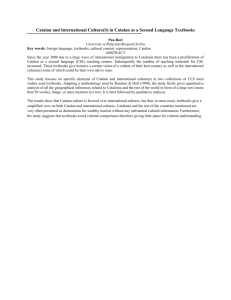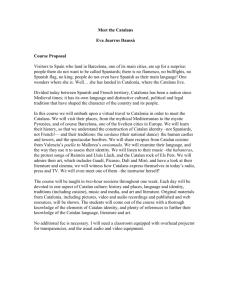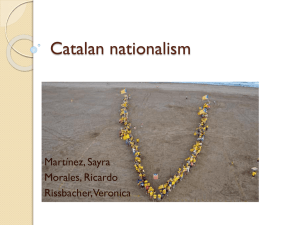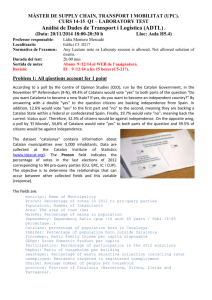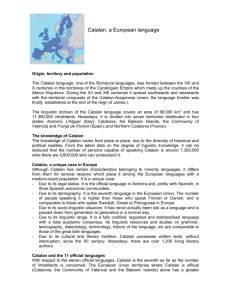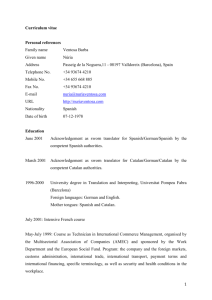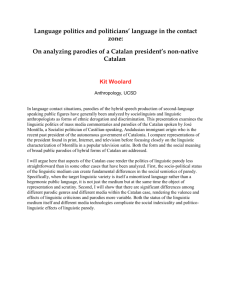Reenactment and Carnival:
advertisement
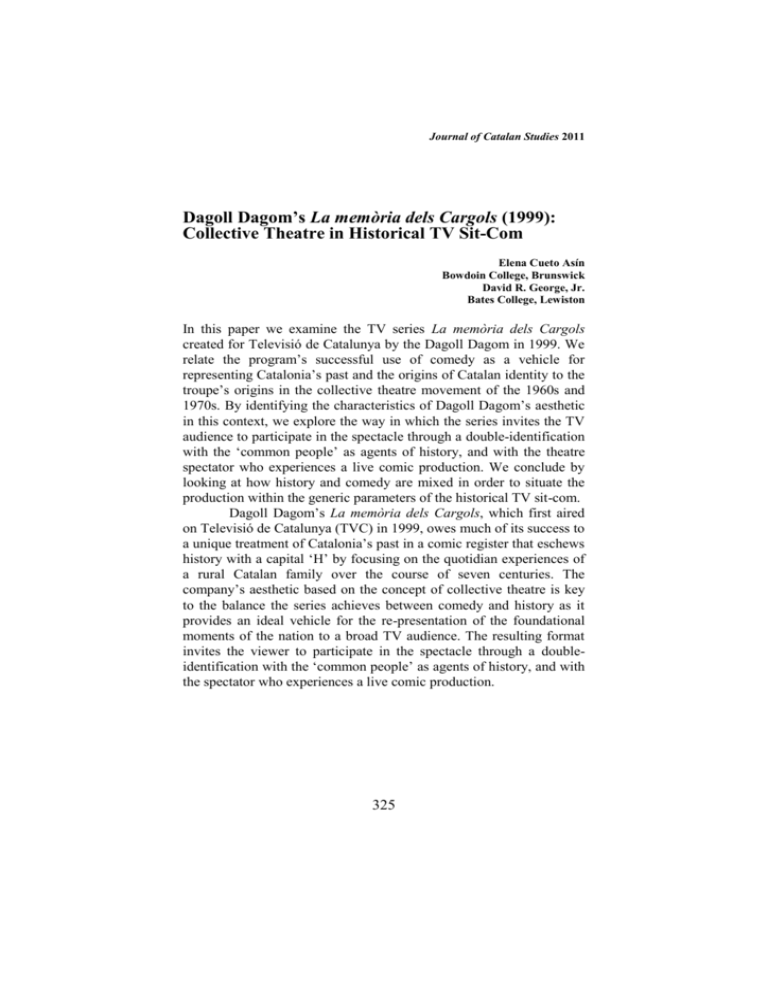
Journal of Catalan Studies 2011 Dagoll Dagom’s La memòria dels Cargols (1999): Collective Theatre in Historical TV Sit-Com Elena Cueto Asín Bowdoin College, Brunswick David R. George, Jr. Bates College, Lewiston In this paper we examine the TV series La memòria dels Cargols created for Televisió de Catalunya by the Dagoll Dagom in 1999. We relate the program’s successful use of comedy as a vehicle for representing Catalonia’s past and the origins of Catalan identity to the troupe’s origins in the collective theatre movement of the 1960s and 1970s. By identifying the characteristics of Dagoll Dagom’s aesthetic in this context, we explore the way in which the series invites the TV audience to participate in the spectacle through a double-identification with the ‘common people’ as agents of history, and with the theatre spectator who experiences a live comic production. We conclude by looking at how history and comedy are mixed in order to situate the production within the generic parameters of the historical TV sit-com. Dagoll Dagom’s La memòria dels Cargols, which first aired on Televisió de Catalunya (TVC) in 1999, owes much of its success to a unique treatment of Catalonia’s past in a comic register that eschews history with a capital ‘H’ by focusing on the quotidian experiences of a rural Catalan family over the course of seven centuries. The company’s aesthetic based on the concept of collective theatre is key to the balance the series achieves between comedy and history as it provides an ideal vehicle for the re-presentation of the foundational moments of the nation to a broad TV audience. The resulting format invites the viewer to participate in the spectacle through a doubleidentification with the ‘common people’ as agents of history, and with the spectator who experiences a live comic production. 325 Journal of Catalan Studies 2011 The story of Can Cargol La memòria dels Cargols, created and directed by Anna Rosa Cisquella and Joan Lluis Bozzo, is comprised of 26 episodes that trace the story of the Cargol family from the foundation of the casa païral in the 13th Century to the present.1 The comedy depicts the intimate, quotidian experiences of the family against a backdrop marked by the main events of Catalan history. The Black Death, the Segadors Revolt, the War of Independence and the Civil War, are refracted and echoed in the imaginary village of Santa Gueraula.2 Over the course of 750 years, the family’s status evolves in-sync with that of neighbours like the rival Esclata-sangs, owners of various small-businesses, and in function with the transformation of power structures represented by the Church, the bourgeoisie and the nobility. The rise from poverty to wealth, and the move from the countryside to the city, does little to change the essence of Can Cargol, which persists as a symbol of continuity of custom, bloodline and authentic being. This echoing of the Renaixença ideology of pairalisme is woven into the series’ structure: the image of the snail with its spiral-shaped shell evoked by the family name is replicated in the manner in which the central characters remain the same in spite of the passage of time. The grandmother, the heir (the hereu), the younger son, the heir’s wife and children, along with the other residents of Santa Gueraula retain their names, personalities and aspirations across generations, and are played by the same members of the Dagoll Dagom troupe. One million viewers were reported to have watched the first episode of La memòria dels Cargols (Baget 1999). From the outset, Bozzo clarified that the series did not intend to be a comprehensive history of Catalonia (Balaguer 1999: 10). In their study of historical series produced for TVC from the 1990s to the present, Enric Castelló 1 The title credits announce the program as ‘Una serie de Dagoll Dagom sobre una idea Anna Rosa Cisquella’. 2 Gueraula does not appear in any book of saints; perhaps the name refers to Gueraula de Codines who, according to the Diccionari Biográfic de Dones, was shaman (guaridora) operating in the Subirats area at the beginning of the 13th Century and accused of witchcraft on various occasions. 326 Journal of Catalan Studies 2011 and Hugh O’Donnell call attention to the way in which this program indeed evades the grandiloquent discourses of Catalan history by focusing of the lives of the common people as a mark of originality (2009: 183). The title avoids a direct allusion to history by evoking instead the notion of memory. Such a move is not accidental and thus begs the question of what is meant by the term memòria in the context of the program. Except for the final episodes that take place in the 20th century, the intention seems not to be to stir up recollections of a recent lived-past as in the case of other TVC programs from the 1990s like Temps de silenci, and later Televisión Española productions like Cuéntame cómo pasó or Amar en tiempos revueltos. All of these series seek to connect audiences to quotidian experiences and social changes directly lived or inherited from a previous generation. By contrast, La memòria dels Cargols calls up a broader historical horizon that extends back from the present to time immemorial (the Cargols appear in the first episode as a fully formed social entity whose origin is unknown to the audience). The use of an instrumental version of the traditional and well-known Catalan children’s song that begins ‘Cargol treu banya…’ played on the shrill tible (Catalan shawm), draws viewers’ attention to the image of the snail’s shell traced out on the screen as a symbol of the type of collective memory that results from the cyclical accumulation of centuries of lived-experiences. The metaphor rooted in Catalan traditional culture recalls Miguel de Unamuno’s reference to another kind of mollusk in the elaboration of his philosophy of history. He illustrates his notion of intrahistoria as the story of the daily and eternal toils of the anonymous people by evoking the image of the madrepora coral; the fruits of the labor of the silent masses is like ‘[…] las madreporas suboceánicas [que] echan las bases sobre las que se alzan islotes de la historia’ (29). The snail imagery used in the series emphasizes a similar connectedness to the land, suggesting the intention to reiterate the notion articulated by Torres Bagés that the pre-industrial social structure of the Catalan countryside was and would continue to be a key differentiating trait of Catalonia (Hargreaves 25). Each episode of La memòria dels Cargols opens with a brief introduction that precedes the title credits: a short voiceover narrative establishes the historical context in 2-3 phrases against a background 327 Journal of Catalan Studies 2011 of archival images and in an authoritative tone that sharply contrasts with the comic presentation that follows. Next, title credits are juxtaposed with a panning shot of the attic of Can Cargols in which objects from the past are stored. The items contained in this space, easily recognizable to followers of the program, reiterate the idea of memory as an amalgamation of experiences by referencing the continuously unfolding story of the family. At the same time that they constitute materially the memory of the Cargols, they also function as the memory of the series as a collection of theatrical props stored backstage. Through this last detail, the viewer is reminded that Dagoll Dagom is first and foremost a theatre company and that the group has chosen to bring its art to the TV media as part of its continuous strategy to reach a broader public. History and collective theatre The independent theatre movement of the 1960s and 1970s cropped up as an alternative to conventional or mainstreams form and encompassed a wide-range of groups conceived in general terms as theater cooperatives. As Mercé Saumell explains: ‘Through different, sometimes contradictory aesthetics [such groups] share two objectives: a left-wing struggle against Franco’s regime and the establishment of a new professional mandate for the theater’ (2001: 5). In spite of the particular political situation in Spain, Catalan and Spanish independent theatre groups participated in an international phenomenon that saw the use of satire, farce, popular comedy and catchy music, and the appropriation of popular elements, such as traditional songs and folk-heritage, as basic ingredients (Saumell 2001: 6). The movement is heir to the Avant-garde’s rupture with the primacy of the literary text and the breaking down of the strict division between art forms and genres. Its modus operandi is one of ‘collective creation’ in which all members of the troupe are involved in the adaptation and production of previously written dramatic texts. The diverse members of such groups leave individual stamps on the script, adding extra-textual details. As Miguel Bilbatua observes ‘a 328 Journal of Catalan Studies 2011 través de motivaciones comunes [el colectivo] logra una unidad dinámica o un collage configurado por vivencias personales’ (10). The ‘choral’ structure of such companies, at least in theory, does not privilege the intervention or ideas of any single member, and injects performances with a degree of improvisational quality that reiterates an underlying disdain for the figure of the playwright (Saumell 2001: 7). All the same, very often these groups are guided by the distinctive vision and concrete aesthetic precepts of a director that gradually erodes the notion of collaborative authorship. Dagoll Dagom is no exception: Bozzo was among the group’s founders and continues to serve as its artistic director. However, each of the company’s productions is the product of collaboration among various artists. In addition to Bozzo, seven other screenwriters collaborated on the script for La memòria dels Cargols, and many of these artists have worked on previous and subsequent projects in different capacities (Ginart 1999). Because of its association with political or cultural vindication, collective and independent theater has often been a vehicle for marginalized ethnic groups seeking visibility within a larger collective and for voicing demands for gender equality. Catalonia has produced particularly large number of such troupes, among which Dagoll Dagom figures prominently. Over its more than 30 year existence, the group has created a wide variety of original spectacles and adaptations of classic and modern dramatic for the theater and for television. Their work has dealt with myriad themes, however the rehabilitation of Catalan culture and history has been a constant throughout their repertory. In plays like Antaviana (1978), based on a text by Pere Calders, Mar i cel (1987) by Angel Guimerà, and Flor de nit (1992) based on texts by Manuel Vázquez Montalbán, they have taken on the canon of Catalan literature. They have also adapted various British plays: Mikado (1986), Pygmalió and Els Pirates (both 1997). In No hablaré en clase (1977), their first major success, Dagoll Dagom made its first of many incursions into the delicate topic of recent history. The play, one of the most successful of the democratic transition, deals with repression in the education system under the Franco dictatorship. The shift to more commercial musical theatre that began with Antaviana, in 1978, represents what 329 Journal of Catalan Studies 2011 Saumell calls ‘a Copernican turn-around for the Catalan theater’ (2001: 18). The group continued to evolve without sacrificing its essence: subsequent productions, in spite of a flashy-mainstream style have not shied from commentary on and satire of contemporary social customs and practices in Catalonia and beyond. For example, Glups! (1983) laughs at mass media and consumer culture in both a local and global context. The growing use of technology and sophisticated electronic lighting and imagery in their shows since the decade of the 1980’s might also explain the company’s progressive approximation to various TV formats. In Catalonia, the troupe is well-regarded as a standard-bearer of the movement to recover and to make visible Catalan culture, history and language. Such credibility gives them ample leeway to combine caricature and irony in the evocation of key discourses and landmarks of Catalan national history in a media capable of reaching a greater audience. In the 1990s, the company began its relationship with Televisió de Catalunya with Oh, Europa (1993) and Oh, Espanya (1996); both series follow the misadventures of a bus-load of Catalan tourist as they journey around Europe and Spain. La memòria dels Cargols might be seen as the logical progression of Dagoll Dagom’s treatment of society and history from the global (European) to the local (Catalonia), passing through the intermediate space constituted by the Spanish State. The company’s most recent TV series, La Sagrada Família (2010) takes this process of zooming one step further by reframing and tightening the focus on the nucleus of society already identified in La memòria dels Cargols: the family. Castelló and O’Donnell point out the way in which Dagoll Dagom is able to make fun of claims for independence and to debunk foundational notions of identity with little negative repercussion; they cite for example the general lack of enthusiasm the gueraulencs show towards the prospects of Catalan sovereignty explored in various episodes (2009: 184). Other more potent instances of irony abound: at the end of the episode ‘La Guerra dels Segadors’, the author of the hymn ‘Els Segadors’ (attributed to oral tradition) is revealed to be none other than the German mercenary paid by the Baron to instigate the revolt. In an ironic twist, the soldier of fortune takes up the Catalan cause after undergoing a shoddily executed trepanation by 330 Journal of Catalan Studies 2011 Pere Pau Esclata-sang, tavern-owner-cum-surgeon. During the delirious operation, as the German’s skull is penetrated and blood spews, he recites the Barça line-up and sings ‘L’estaca’ before embracing a doctrine of non-violence. In ‘Els Pastorets’, as shall be seen below, an ethnographer from Barcelona travelling by bicycle to document folklore and customs is tricked into paying for songs, stories and a local version of a nativity mystery play (through a series of ‘lliçons de pagesía’), all made-up on the fly by the money-hungry Cargols and their neighbors. La memòria dels Cargols as Sit-Com The fact that Dagoll Dagom, a well-established professional theater company, accepted the challenge of retelling Catalan history in a comic mode, in our opinion is another key feature of the success of La memòria dels Cargols in 1999, and in subsequent re-runs on TV3 and TV3000. Luisa Martínez has studied the evolution of TV fiction in Catalonia as well as the ways in which humour in the context of the situation comedy reflects cultural identity. It is striking that in her description of the evolution of fictional series produced by TVC, La memòria dels Cargols is not included in the catalogue of sit-coms, but rather is grouped with other ‘series històricas’ like Arnau (1984) and Histories de Catalunya (2003-05) (Martínez 2008). Likewise, Castelló and O’Donell also pay little attention to question of genre in their discussion of the series. Indeed, the very fact that the program deals with the ‘serious’ matter of Catalan history, from the perspective of these scholars, trumps all other classifications. Nonetheless, La memòria dels Cargols undeniably falls within the established parameters of the sit-com, and its treatment of history is determined by the way in which Dagoll Dagom employs the commonplaces of this genre. In fact, what we argue is that the Catalan series be considered a historical or period sit-com. Castelló and O’Donnell point out that the production is historically accurate in terms of content and mise-en-scene, yet the possible limitations of such documentation in the interest of appealing to a mass audience are circumvented by the program’s tone and 331 Journal of Catalan Studies 2011 format. The use of comedy is never disrespectful, and as a result they recognize La memòria dels Cargols as ‘una de las pocas series del Estado Español , si no la única, que se toma la historia con humor sin renunciar por ello a un respecto riguroso de los hechos’ (Castelló & O’Donnell, 2009: 183). Given the group’s trajectory on the stage as well as on the small screen, it is should not be surprising that it lent its creative vision to a project located at the centre of TVC’s mission as a public service broadcaster. The series’ comic element has been categorized as irony: Bozzo defines the treatment of history as a combination of ‘ternura e ironía’, and La Vanguardia TV critic J.M. Baget refers to it as ‘una ironía relativizadora […] una lúcida reflexión sobre nuestra historia y un sano ejercicio de autocrítica sin victimismo ni grandilocuencia’ (1999). Later, the same critic praises the way Dagoll Dagom takes on the task of representing delicate moments of the recent past such the Civil War or the Dictatorship (1999). Such a use of satire and parody in the series can be traced back to Dagoll Dagom’s origins in the independent theatre movement when ‘censorship forced theatre to use parable and parody, both textual and visual, as dramatic tools’ (Saumell 2001: 5). Even in the absence of an official regime of censorship, there still exist certain taboos regarding the treatment of certain periods and topics. The British period sit-com Blackadder (1983-2000) perhaps influenced the creators of the Catalan series, if only in terms of demonstrating the market viability of a situational comedy set in the past. The brand of humour used in the treatment history in the two programs is somewhat different: whereas Blackadder seeks to satirize ‘the banality of popular conceptions of English history’, La memòria dels Cargols reinforces certain essential truths about the formation of the Catalan nation through laughter (Neale & Krutnik 246). This tactic might permit Dagoll Dagom to carry its exploration of history all the up to the present, where Blackadder director Rowan Atkinson’s stops at World War I.3 3 Various critics recognize that the decision to set the final instalment of the series in the trenches of World War I was already a risk that nonetheless paid off; the program was lauded for its successful of such a delicate subject through comedy (Hanna, 2009: 132-33). 332 Journal of Catalan Studies 2011 Filmed on video tape, the visual style of La memòria dels Cargols emphasizes the ‘liveness’ of the performance on the small screen and situates the program within the parameters of the sit-com. Similar to theater, and quite different from cinema, a key aspect of the TV viewing experience is the heightened sense of proximity between spectator and spectacle that created through the illusion of witnessing a live-performance in the present (Auslander 15). Such an effect is especially relevant and unique in the case of a historical series whose albeit covert didactic mission is to bridge the gap between past and present. As is true of live-theatre, the action of La memòria dels Cargols takes place in a limited number of fixed sets, repeated from one episode to another over the course of the series. Most scenes occur indoors (the Baron’s Palace, Can Cargols, the parish church and the Escalatasangs’ tavern), although several obviously artificial exterior scenes are also frequent (the Font de la Beateta, the town square and a clearing in the woods). Characters never move between settings on screen; rather the sense of spatial and temporal continuity or simultaneity is achieved through the use of jump-cuts and other transitional devices. La memòria dels Cargols upholds the Classical definition of theater in which comedy can only be contextualized among the popular classes, in opposition to tragedy, which is always reserved for the nobility. Although the social and economic standing of the Cargols progresses over the centuries, from humble peasant origins in the 1300s to proto-middle-class stability by the turn-of-the 20th century, the transformation of the characters and their livelihoods does not bring about a change in the dramatic form used to represent their story. The series remains a farce throughout, and resists falling into melodrama, the middle-class genre par excellence. Moreover, the upper-class baron’s histrionic manners also hold tragedy at bay by absorbing these tendencies into the farce. Nonetheless, certain strains on the dramatic structure do appear as the Cargols live through the defining moments of the 20th century: the Second Republic, the Civil War and the Francoist repression drain the show of some of its farcical tone, leaving in its place an undefined tension that remains unresolved for the sake of avoiding melodrama. While courageous for taking up 333 Journal of Catalan Studies 2011 these delicate events, in our opinion, these episodes mark a low-point in the series that exposes the difficulties of dealing with recent history in the TV sit-com format. TVE’s recent comedy series Plaza de España (2011), set in a small village during the Civil War, provides further proof of the pitfalls of dealing with these events on the small screen: in spite of adopting a brand of dark humour reminiscent of Luís García Berlanga’s successful film La vaquilla, the show failed to crystallize as such. Neale and Krutnik, in their study of comedy on TV and film, call attention to the way in which situation comedies reaffirm cultural identities by defining a community of shared values and interests (242). The ‘communalizing effect’ of the sit-com invites the audience to identify with the norms of social behaviour and cultural practice associated with the prototypical middle-class environment showcased on-screen. In this light, it can be argued that La memòria dels Cargols connects with Catalan audiences by locating these values within a recognizable context of everyday familial and communal ties that evolve through history. More important, the persistence of these relations and practices over the course of time imbues them with added value as enduring markers of Catalan national identity. Through farce Dagoll Dagom’s comic theatre opens a space for self-criticism that invites spectators to laugh at themselves and at the sacred institutions of the nation. Likewise, the group’s work for TVC is characterized by a hybridization of comic modes that is not only essential to the farce, but also a distinguishing feature of the TV situation comedy (Neale & Krutnik 18). In the 26 episodes of La memòria dels Cargols, instances of laughter are achieved through a combination of modes: satire, parody and slapstick. Through satire, the critical irony of specific social institutions or conduct is sought. In the program this kind of humour is sufficiently soft and dispersed such that no one group or individual is prejudiced. The manipulative power of the priest (played by Joan Bozzo) is exposed and criticized without taking on an anticlerical tone. The villagers tolerate the baron’s open homosexuality as normal behaviour in a way that reflects contemporary social values of tolerance; at the same it reveals the historical fact that the free expression of sexual identity was a privilege of the aristocracy. 334 Journal of Catalan Studies 2011 Parody or burlesque allusions to other genres, artistic productions or aesthetic modes happen most notably in those instances in which the residents of Santa Gueraula come into contact with or face the imposition of Castilian language, culture and power. The pompous diction of Golden Age theatre and notes of cruel casticismo are echoed in the speech of Urraquita, to whom the baron is wed in the 15th century. Following the War of Succession, the villagers feign knowledge of Castillian, dress-up as Aragonese and dance ‘jotas’ to receive the Philip V’s emissary in a scene that recalls Berlanga’s masterpiece Bienvenido, Mister Marshall). These moments are sufficiently balanced with notes of self-criticism so as not to become corrosive or offensive to sectors of the Catalan audience that hail from outside Catalonia. Examples that can be categorized as slapstick are likewise constrained such that the victims of slaps, kicks, and falls never completely lose their humanity or dignity. For example, Constança (the mother) and Padrina (the grandmother) frequently reprimand Ramonet (l’Hereuet) with tugs on the ears and blows to the head for his playful indiscretions or naïve initiatives that threaten to disrupt or jeopardize the familial order. The young character’s momentary suffering provokes laughter precisely when the elder Cargols find themselves obliged by historical circumstances to make less than admirable choices or concessions to get by in life and to preserve the family. Slapstick in the series occurs at narrative junctures in which the plot necessitates the audience’s recognition of the characters’ physicality but, unlike traditional slapstick that revels in exposing the essential lack of dignity that defines the human condition, here it is used to draw attention to the absurd situations of history that require absurd responses from the collective to overcome them. In this way, the tactic in La memòria dels Cargols reflects what Sara Jane Bailes refers to when she describes the gag as a ‘hopeful utopic impulse, where misfortune is turned into fortune and disadvantage into advantage’ (2010: 41). The happy-ending is a defining component of the sit-com that signals a return to the established familial and social order following the resolution of the incident that temporally questioned its continuity (Neale & Krutnik 241). Catalan society in La memòria dels Cargols 335 Journal of Catalan Studies 2011 evolves through history thanks to a series of small but successful rebellions against the status quo. These upheavals are never allowed to compromise the unity of the family or society, and are always ultimately shown to lead to the overall betterment of the community. This occurs in the episode ‘Ball de quinto’ when the family tries to find a way to commute Bernat, the second-son, from doing military service in Cuba in 1869. In the end, he accedes when it becomes clear that in order to buy his freedom part of the family land, accumulated over generations, would have to be sold-off. ‘Els pastorets’ The mingling of history, humour and theatre in the TV sit-com format that occurs in La memòria dels Cargols is perhaps best observed in episode 19, ‘Els pastorets’. The arrival of ethnographer Higini Peix i Cirera, dispatched from the fictitious Institut de Recerca Popular to Vall de Santa Gueraula in search of folklore ‘a punt de perdre’s’, serves as the backbone to a narrative that explores the transformation of the pagès and the traditional social order in the first decade of the 20th century. Faced with encroaching industrialization and tough economic times, the villagers debate the merits of forming an agricultural cooperative that would allow them to update their traditional farming techniques. Ramon Cargol resists the initiative led by his brother Bernat since it would mean an erosion of the celebrated independence of the pagès. Seeking to get by, and to finance the purchase of American oak barrels for the aging of wine on his own, the family agrees to take in the folklorist from Barcelona as a boarder. Padrina is the first to discover the lucrativeness of arrangement when the scholar implores her to share with him popular songs, stories and dances in exchange for money. Eventually the whole family and the rest of the village joins in, and once they run out of material they start to invent things to prevent Peix i Cirera from leaving. The Cargols’ scheming draws out stereotyped images of the greedy Catalan. At the same time, the image of the hard-working pagès is also debunked when the scholar is tricked into performing all sort of manual labor (chopping wood, shovelling manure, etc.) while the family lies about. 336 Journal of Catalan Studies 2011 Within the confines of the episodes La memòria dels Cargols corroborates and contradicts clichés of Catalan identity. When Peix i Cirera finally announces his departure, saying that he has collected enough materials, the Cargols and their neighbours collude to create from scratch the local nativity play to which he had found vague references in a bundle of old papers in the baron’s castle. The guerualencs’ falsification of the traditional play depicting the adoration of the shepherds of the infant Jesus in ‘Els Pastorets’ is one of many examples that occur throughout the series in which an alternative and absurdly plausible explanation of the origin of an emblematic Catalan cultural practice is offered to viewers. The process of reinventing the medieval play mirrors on the small screen the modus operandi of Dagoll Dagom as a theatre collective that draws on traditional sources (folklore) in order to contest the conventions of bourgeois theatre. The episode is a meta-theatrical exercise that constitutes a potentially potent form of self-criticism: by making fun of the efforts to reinvent Catalan culture in the late nineteenth and early twentieth centuries, the theatre group’s participation in the independent theatre movement that was driven by similar impulses to rescue and revive traditional culture also becomes an object of parody. The collaborative writing of Els Pastorets, which involves the entire cast of characters under the direction of the town priest played by Bozzo, allows TV viewers to witness the very process through which La memòria dels Cargols itself has been produced. The use of comedy here is therefore critical but not entirely irreverent: while the deception of the ethnographer and the community’s invention are to be laughed at, the cultural practices underlying both the ethnographic project and the collective endeavour to protect and defend tradition through the vindication of the differentiating features a rural-based Catalan culture, are upheld and celebrated. Within the overall structure of the series, ‘Els pastorets’ marks a fundamental shift in the way in which history is dealt with. Peix i Cirera is overwhelmed and ecstatic following the villagers’ representation of the mystery play which contains all of the expected elements so as to be easily recognizable as ‘authentic’ to any TV viewer who has attend such performances or has seen them on TVC. As the young man bids farewell, Ramon Cargols hands him a bill for 337 Journal of Catalan Studies 2011 the play as well as a long list of other services rendered during his stay. When he reveals that the scholarship money was spent up, the comedy is momentarily suspended as he is driven violently from Can Cargol. The situation is softened by the fact that the daughter Eva Cargol flees to Barcelona with him, and shortly thereafter the mayor returns from the capital with a copy of Peix i Cirera’s book El gran costumari de Santa Gueraula. The neighbours laugh at the strange catalogue of customs until the mayor reminds them that they will have to begin to conduct themselves according to the book; such a twist provides a humorous vindication of the abuse the ethnographer endured because of his naïve enthusiasm. ‘Els Pastorets’ is the last chapter in which farce need not be constrained by the delicacy and crudity of the political and social events that define the Cargol’s experience of recent history. The violent manner in which the ethnographer is in the end driven from the town anticipates similar actions that in the 1930s and 1940s cannot be treated in such a farcical manner. Conclusion TVC takes advantage of the rich tradition of collective theater in Catalonia to craft a witty but accurate history of the nation that meets the demands of TV viewer to be both informed and entertained. In its role as a public-service broadcaster, the entity is committed to preserving and promoting cultural identity, and, no doubt, La memòria dels Cargols complies with this mission without sacrificing the brand of humour that characterizes Dagoll Dagom’s theatre. The contours of Catalan identity are pondered in the series in two ways: first, by reenacting a history of local traditions adapted to the necessities of progress, and distilled by novelties originating from outside the community. Second, by participating in the movement of modern Catalan theatre that is consolidated during the democratic transition when groups like Dagoll Dagom began to explore the possibilities of recovering in full freedom Catalonia’s history, language and culture. At the same time, the use of the sit-com formula connects La memòria dels Cargols to an internationally established TV genre based on US 338 Journal of Catalan Studies 2011 and UK models. Such a move is completely coherent in light of the trajectory of a theatre company that has looked abroad as much as at home for inspiration. Bibliography Auslander, P. (1999). Liveness: Performance in mediatized culture. London: Routledge. Baget Herms, J.M. (1999). ‘Un “flashback” de 750 años’. Vivir. La Vanguardia [online] 20 Jan. Available at: LaVanguardia.com. [Accessed: 10 December 2010]. ______ (1999). ‘Un sano ejercicio de autocrítica’. Vivir. La Vanguardia [online] 1 April. Available at: LaVanguardia.com. Web. [Accessed: 10 Dec. 2010]. ______ (1999). ‘La posguerra según la familia Cargol’. Vivir. La Vanguardia [online] 23 June. Available at: LaVanguardia.com. [Accessed: 10 December 2010]. Bailes, S.J. (2010). Performance Theatre and the Poetics of Failure. London: Taylor & Francis. Balaguer, A. (1999). ‘TV3 estrena la serie cómica La memòria dels Cargols’. Vivir. La Vanguardia [online] 16 January. Available at: LaVanguardia.com. [Accessed: 10 December 2010]. Bilbatua, M. (1970). ‘Sobre el papel del «autor» en el teatro independiente’. Primer Acto, 121, 10-12. Castelló, E. & O’Donnell, H. (2009). ‘Historias de Catalunya. Ficción y memoria histórica en TVC’. In: F. L. LT, E. Cueto Asst & D.R. George, Jr., Historias de la pequeña pantalla. Madrid/Frankfurt: Iberoamericana/Veuvert. 175-196. García Templado, J. (1996). ‘La crisis del lenguaje en el “Nuevo Teatro” español’. Espéculo [online] 2. Available at: http://www.ucm.es/info/especulo/ [Accessed: 30 November 2010]. Ginart, B. (1999). “TV3 estrena la nueva serie de Dagoll Dagom La memòria dels Cargols.” El País [online] 12 January. Available at: http://www.elpais.com [Accessed: 29 November 2010]. 339 Journal of Catalan Studies 2011 Hanna, E. (2009). The Great War on the Small Screen. Edinburgh: Edinburgh University Press. Hargreaves, J.E.R. (2000). Freedom for Catalonia? Cambridge: Cambridge University Press. La memòria dels Cargols (1999). [TV program online] TV3, Televisió de Catalunya. Available at: http://www.tv3.cat/programa/120086646/La-memoria-delsCargols [Accessed: 12 December 2010]. Martínez, L. (2008). ‘Evolución de la ficción propia de TV3’. Informes: Observatori de la producció audiovisual. [online] Barcelona: Universitat Pompeu-Fabre. [Accessed: 8 December 2010]. Neale, S. & Krutnik, S. (1999). Popular Film and Television Comedy. London: Routledge. Saumell, M. (2001). ‘Performance Groups in Contemporary Spanish Theatre’. Contemporary Theatre Review 7(4): 1-30. Unamuno, M. (1999). En torno al casticismo. Madrid: Espasa-Calpe. Vinyoles Vidal, T. (2011). ‘Gueraula de Codines’. Diccionari Biográfic de Dones. [online] Available at: http://www.dbd.cat [Accessed: 30 September 2011]. 340

